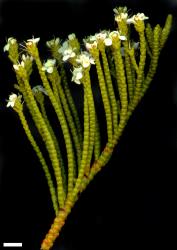- Taxon
- Gallery
- ≡ Hebe hectorii (Hook.f.) Cockayne & Allan, Trans. New Zealand Inst. 57: 40 (1926)
- ≡ Leonohebe hectorii (Hook.f.) Heads, Bot. Soc. Otago Newsl. 5: 8 (1987)
Whipcord shrub to 1.0 m tall. Stems ascending to erect, glabrous except for a line of eglandular hairs at the connate leaf bases. Leaf bud indistinct, its outer leaves fully grown, diverging. Leaves opposite-decussate, connate in pairs and encircling stem, appressed and usually covering the well-marked node above, scale-like; lamina coriaceous, deltoid to broadly deltoid to sub-orbicular, 1.5–3.5 mm long, 2.0–4.5 mm wide, glossy green, olive-green, or yellowish-green above and beneath; midrib and veins not evident; surfaces glabrous; margin ciliolate, entire (incised to dentate in juvenile and reversion leaves); apex obtuse, sub-acute, apiculate, or mucronate; base broad; petiole absent. Inflorescence a terminal spike, 3.5–15.0 mm long; flowers crowded, 4–16, all bisexual or some female; bracts opposite-decussate, connate, deltoid; pedicels absent. Calyx lobes 4–5 (usually free or rarely anterior pair fused from ⅓ to ⅔ of the way to apex; 5th lobe small, posterior), obtuse to sub-acute, sub-equal, 1.5–3.0 mm long, usually eglandular-ciliate with long, deflexed, sinuous hairs, sometimes ciliolate, mixed with short glandular hairs as well. Corolla 5.0–8.5 mm diameter, tube white, 1.5–2.5 mm long, ≤calyx, eglandular-hairy inside; lobes 4, white, erect to spreading, sub-equal, oblong to ovate to broadly elliptic, 3.0–4.5 mm long, obtuse; nectar guides absent. Stamen filaments white, 3.5–4.2 mm long; anthers pink to purple. Style glabrous, 3.3–6.5 mm long. Capsule latiseptate, obtuse to sub-acute, 1.8–3.2 mm long, 1.8–2.5 mm at widest point. Seeds ellipsoid to oblong, flattened, smooth, straw-yellow or brown, 0.9–1.4 mm long.
| 1 | Leaf apex of some or most leaves apiculate or mucronate | subsp. demissa |
| Leaf apex sub-acute or obtuse or rounded | 2 | |
| 2 | Leaves longer than to about as long as broad, mostly 1.2–2.0 mm, occasionally to 2.7 mm, long (northern South Island) | subsp. coarctata |
| Leaves broader than long, mostly 1.7–3.1 mm, occasionally 1.2–2.7 mm long (southern South Island) | subsp. hectorii |
The differences between V. hectorii and V. tetragona plants are slight and were discussed in detail by Bayly & Kellow (2006), along with discussion of various options for taxonomic treatment at species rank. Although they are very similar, differences in flavonoid chemistry and distribution support their recognition at species rank (Bayly & Kellow 2006).
V. tetragona and V. hectorii can be reliably distinguished by the thickened leaf apex of V. tetragona, compared to that of V. hectorii, which is not thickened (Bayly & Kellow 2006, Fig. 48, p. 91). The strongly tetragonous to cruciform leafy branchlets of V. tetragona subsp. tetragona provide a clear distinction from V. hectorii, but the more rounded branchlets of subsp. subsimilis are not so easily distinguished, particularly from V. hectorii subsp. coarctata.
Bracts and calyx lobes, but not the leaves, often have one to several longitudinal ribs, resembling the leaves of V. lycopodioides and V. poppelwellii.
South Island: Western Nelson, Sounds Nelson, Westland, Canterbury, Otago Southland, Fiordland.
Stewart I.
Montane to alpine grassland and shrubland.
| Category | Number |
|---|---|
| Indigenous (Endemic) | 3 |
| Total | 3 |
Veronica hectorii hybridises occasionally with V. odora, to form whipcord-like plants, but with longer leaves and internodes. In general, the parentage of V. odora × whipcord hybrids is hard to deduce from morphology, and in the field proximity of putative parents is the best criterion.
Flowers: November–April; Fruit: January–June (persisting all year).
2n = 40 (Bayly & Kellow 2006, as Hebe hectorii).
Veronica hectorii is classified in V. subg. Pseudoveronica sect. Hebe and informally in the “Flagriformes” group, also known as whipcord hebes (Albach & Meudt 2010; Bayly & Kellow 2006).




